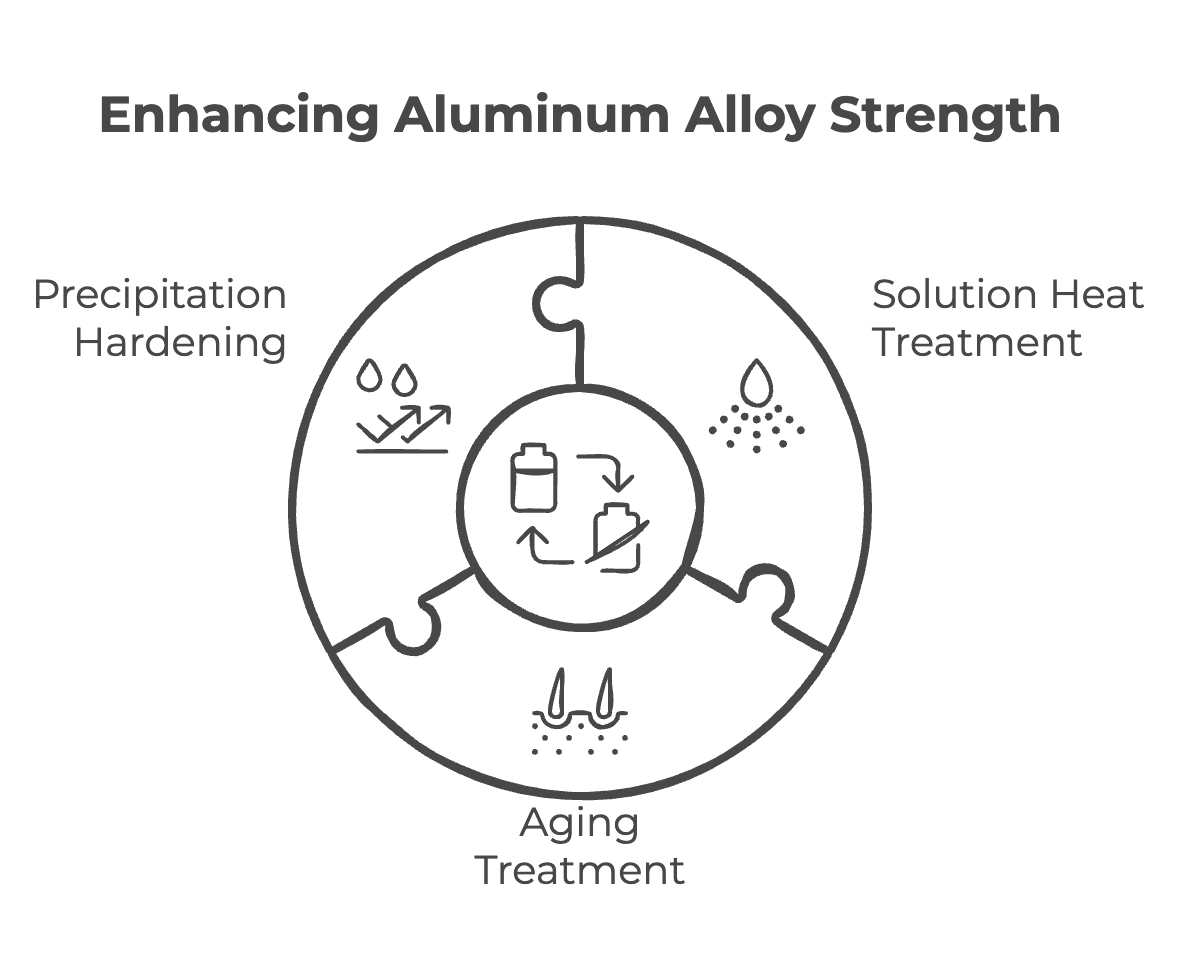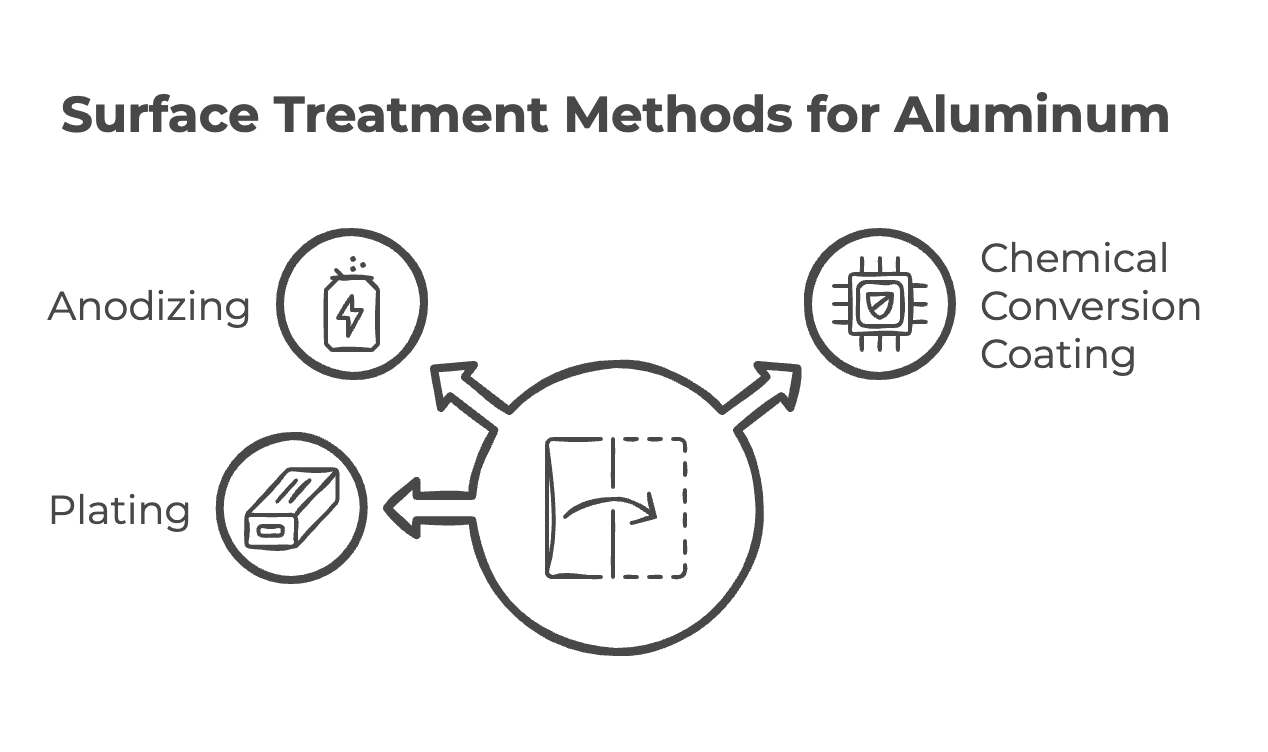◆Table of contents
ToggleIntroduction
Aluminum is used in a wide range of fields such as aircraft, automobiles, and construction due to its excellent properties such as lightweight, corrosion resistance, and processability. However, it also has the aspect of relatively low strength.
Therefore, this article introduces technologies to increase the strength of aluminum. By improving strength, it is possible to achieve product weight reduction, high performance, and improved durability, and further expand the scope of application of aluminum.
Specifically, we will explain the main approaches such as heat treatment, processing, and surface treatment. By understanding the characteristics and effects of each method, you will be able to select the optimal strength improvement technology for your purpose.
Strength Improvement by Heat Treatment
Heat treatment is a process that improves properties such as strength and hardness by heating and cooling metal materials to change their structure. Aluminum alloys can significantly increase their strength through heat treatment, making them useful in a variety of applications.
Overview of Heat Treatment
Heat treatment is a widely used technique for improving the strength of aluminum alloys. By heating and cooling metal materials, the atomic arrangement and crystal structure change, and the material properties change. In the case of aluminum alloys, the strength can be increased by generating fine precipitates or refining crystal grains through heat treatment.
Main Heat Treatment Methods
The main heat treatment methods for increasing the strength of aluminum alloys are as follows:
- Solution Heat Treatment: A treatment that heats an aluminum alloy to a high temperature and uniformly dissolves the alloying elements in the solid solution. By rapidly cooling, a supersaturated solid solution is formed, preparing for precipitation hardening by subsequent aging treatment.
- Aging Treatment: A treatment that generates fine precipitates and improves strength by holding at a constant temperature for a certain period of time after solution heat treatment. There are natural aging and artificial aging for aging treatment. Natural aging is an aging phenomenon that occurs at room temperature, and artificial aging is an aging phenomenon that occurs at high temperature for a short time.
- Precipitation Hardening: A phenomenon that generates fine precipitates by aging treatment, inhibits the movement of dislocations, and improves strength. Precipitates increase the resistance to material deformation by preventing the movement of dislocations and improve strength.
Application Examples of Heat Treatment
Heat treatment is used to improve the strength of various aluminum alloys.
- 6061 Aluminum Alloy: The tensile strength is improved by about 30% by performing aging hardening treatment after solution heat treatment.
- 7075 Aluminum Alloy: Both high strength and toughness can be achieved by performing aging hardening treatment after solution heat treatment.
Precautions for Heat Treatment
The following points should be noted when performing heat treatment.
- Overaging: Excessive aging treatment can cause coarsening of precipitates and conversely reduce strength.
- Heat Treatment Conditions: It is necessary to strictly control the appropriate temperature and time according to the type of alloy and the desired properties. If the heat treatment conditions are inappropriate, not only will the expected strength improvement effect not be obtained, but the material properties may be deteriorated.
Heat treatment is a very important technique for improving the strength of aluminum alloys. By performing appropriate heat treatment, aluminum alloys can be used in various fields.
Strength Improvement by Processing
Aluminum is used in various fields due to its excellent properties, but by further increasing its strength, it can be used in a wider range of applications. One of the effective means for this is “processing.”
| Category | Content | Details |
|---|---|---|
| Overview | A technique that improves strength and hardness while changing the shape by applying force to the aluminum material and plastically deforming it. | Increases material strength by refining the crystal structure using work hardening. |
| Main Processing Methods | Cold Working | Increases strength by increasing dislocation density by processing at room temperature. |
| Rolling: Increases strength while rolling a plate-like material between rolls and stretching it thinly. | ||
| Drawing: Increases strength while passing the material through a die and reducing the cross-sectional shape. | ||
| Forging: Increases strength while hitting the material with a hammer and forming it. | ||
| Hot Working | Increases strength by reducing the deformation resistance of the material by processing at high temperature, making it easier to process into complex shapes, and refining crystal grains by recrystallization. | |
| Strength Improvement Mechanism | Work Hardening | Strength increases as dislocation density increases due to plastic deformation and dislocation movement is inhibited. |
| Grain Refinement | Strength and toughness are improved as crystal grain boundaries increase and dislocation movement is inhibited by refining crystal grains through processing. | |
| Application Examples | Cold Rolling | Can increase the strength of aluminum plates by up to 50%. |
| Forging | Improves the strength and toughness of aluminum alloys and is used for aircraft parts, etc. | |
| Precautions | Degree of Processing | It is important to select an appropriate degree of processing because excessive processing may reduce the ductility of the material. |
| Residual Stress | Since residual stress is generated by processing, removal by heat treatment is necessary as needed. Residual stress causes a decrease in the fatigue strength of the material. |
Overview of Processing
Processing is a technique that improves properties such as strength and hardness while changing the shape of an aluminum material by applying force to plastically deform it. It increases the strength of the material by refining the crystal structure using a phenomenon called work hardening.
Main Processing Methods
There are two main types of aluminum processing methods: cold working and hot working.
- Cold Working: A method of processing at room temperature. It increases strength by increasing dislocation density. Rolling, drawing, and forging are typical cold working methods.
- Rolling: Increases strength while rolling a plate-like material between two rolls and stretching it thinly.
- Drawing: Increases strength while passing the material through a die and reducing the cross-sectional shape.
- Forging: Increases strength while hitting the material with a hammer and forming it.
- Hot Working: A method of processing at high temperature. It reduces the deformation resistance of the material, makes it easier to process into complex shapes, and increases strength by refining crystal grains by recrystallization.
Strength Improvement Mechanism by Processing
Strength improvement by processing is mainly caused by the following two mechanisms.
- Work Hardening: Strength increases as dislocation density increases due to plastic deformation and dislocation movement is inhibited.
- Grain Refinement: Strength and toughness are improved as crystal grain boundaries increase and dislocation movement is inhibited by refining crystal grains through processing.
Application Examples of Processing
Processing technology is used to improve the strength of various aluminum products.
- Cold Rolling: Can increase the strength of aluminum plates by up to 50%.
- Forging: Improves the strength and toughness of aluminum alloys and is used for aircraft parts, etc.
Precautions for Processing
The following points should be noted when processing.
- Degree of Processing: Excessive processing may reduce the ductility of the material. It is important to select an appropriate degree of processing.
- Residual Stress: Since residual stress is generated by processing, removal by heat treatment is necessary as needed. Residual stress causes a decrease in the fatigue strength of the material.
The strength of aluminum can be effectively increased by selecting an appropriate processing method and adjusting processing conditions.
Strength Improvement by Surface Treatment
While aluminum has excellent properties such as lightweight and ease of processing, surface hardness, wear resistance, and corrosion resistance may not be sufficient. Therefore, by applying surface treatment, these properties can be improved and the strength of aluminum can be further increased.
Overview of Surface Treatment
Surface treatment is a treatment to improve corrosion resistance, wear resistance, strength, etc. on the surface of aluminum materials. By performing surface treatment, the durability of aluminum can be improved and it can be used even in more severe environments.
Main Surface Treatment Methods
The main surface treatment methods for aluminum are as follows:
- Anodizing: A treatment that electrolyzes aluminum in an electrolyte to form an oxide film on the surface. It can improve corrosion resistance, wear resistance, and decorative properties. Hard anodizing imparts particularly high hardness and wear resistance.
- Chemical Conversion Coating: A treatment that forms a film on the aluminum surface using chemicals. It can improve corrosion resistance and paint adhesion.
- Plating: A treatment that deposits other metals on the aluminum surface. It can improve corrosion resistance, wear resistance, and decorative properties. Nickel-chromium plating can increase the surface hardness to HV800 or more.
Strength Improvement Mechanism by Surface Treatment
By surface treatment, the strength of aluminum is improved by the following mechanism.
- Surface Hardness Improvement: The surface hardness of aluminum is improved by hard anodizing or plating, and wear resistance and strength are increased.
- Composite Effect: By combining surface treatment with other strength improvement techniques (heat treatment and processing), a synergistic effect can be obtained and higher strength can be achieved.
Application Examples of Surface Treatment
Surface treatment is used for various aluminum products.
- Anodizing: Used in a wide range of fields such as building materials, automobile parts, and electronic equipment.
- Plating: Used for products that require high durability, such as decorative items, machine parts, and molds.
Precautions for Surface Treatment
The following points should be noted when performing surface treatment.
- Treatment Conditions: It is necessary to optimize the treatment conditions (temperature, time, chemical concentration, etc.) according to the type of treatment and the desired properties.
- Environmental Impact: Some surface treatments may have a high environmental impact, so it is necessary to select an appropriate treatment method.
Surface treatment is one of the effective means to increase the strength of aluminum. By performing appropriate surface treatment, the performance of aluminum products can be greatly improved.
Combination of Multiple Strength Improvement Methods
To increase the strength of aluminum, there are various methods such as heat treatment, processing, and surface treatment, but by combining these technologies, synergistic effects that cannot be obtained by a single method can be expected.
Combination Examples
By combining multiple strength improvement methods, it is possible to take advantage of the strengths of each technology and compensate for the weaknesses. The following are typical combination examples.
- Solution Heat Treatment + Cold Working: Solution heat treatment homogenizes the structure of the aluminum alloy, and cold working increases the strength. This combination can improve strength and ductility in a balanced manner.
- Age Hardening Treatment + Anodizing: Age hardening treatment increases the strength of the aluminum alloy, and anodizing improves corrosion resistance. This combination is effective for applications requiring high strength and corrosion resistance.
Precautions for Combination
The following points should be noted when combining multiple strength improvement methods.
- Compatibility of Each Treatment: Depending on the order and conditions of the treatments, the expected effect may not be obtained. For example, when surface treatment is performed after heat treatment, the effect of surface treatment may be impaired depending on the temperature of heat treatment.
- Cost: Combining multiple treatments can increase costs. It is necessary to compare and examine the cost required for strength improvement and the effect obtained, and select the optimal combination.
By combining multiple strength improvement methods, the strength of aluminum can be further increased. However, it is important to consider the compatibility and cost of each treatment and select the optimal combination.
Other Strength Improvement Technologies and Future Prospects
In addition to traditional methods such as heat treatment, processing, and surface treatment, new technologies such as nanotechnology and composite materials have appeared as aluminum strength improvement technologies.
Nanotechnology
Nanotechnology is a technology that manipulates materials at the atomic and molecular level. By applying nanotechnology to aluminum alloys, it is possible to generate nano-sized precipitates and achieve high strength that could not be achieved by conventional methods.
Nano-sized precipitates contribute greatly to strength improvement because they more effectively inhibit the movement of dislocations. Furthermore, by making full use of nanotechnology, it becomes possible to control the structure of aluminum alloys more precisely and improve not only strength but also other properties such as ductility and corrosion resistance at the same time.
Composite Materials
Composite materials are materials that combine two or more types of materials to take advantage of the strengths of each material and compensate for the weaknesses. By combining aluminum alloys with other materials (e.g., carbon fibers and ceramics), strength and rigidity can be significantly improved.
Composite materials are attracting attention in the aerospace and automotive fields because they are lightweight and have high strength. In the future, the development of higher-performance composite materials will advance, and aluminum composite materials are expected to be used in various fields.
Future Prospects
Research and development of aluminum strength improvement technology is still actively underway. In the future, research is expected to proceed in the following directions.
- Development of New Strength Improvement Technologies: In addition to further developing existing technologies, it is expected that strength improvement technologies based on completely new principles will be developed.
- Improvement of Existing Technologies: Improvements will be made to realize existing technologies more efficiently and at lower cost.
- Optimization by Combining Multiple Technologies: Research will be conducted to achieve higher strength by combining multiple technologies such as heat treatment, processing, surface treatment, nanotechnology, and composite materials.
Aluminum strength improvement technology is an important technology that contributes to the development of various fields. Through future research and development, aluminum will become a higher-performance material and enrich our lives.
Summary
Aluminum is used in various fields due to its properties, but strength deficiencies can be a problem. This paper explains the synergistic effects of heat treatment, processing, surface treatment, and combinations of these, which are the main techniques for increasing strength.
Heat treatment is a technique that changes the structure and increases the strength, and typical examples include solution heat treatment, aging treatment, and precipitation hardening.
Processing is a technique that increases strength by utilizing plastic deformation, and includes cold working and hot working.
Surface treatment is a technique that improves corrosion resistance and wear resistance, and includes anodizing, chemical conversion coating, and plating.
Synergistic effects can be expected by combining these techniques. In recent years, new technologies such as nanotechnology and composite materials have appeared, and aluminum strength improvement technology continues to evolve.


